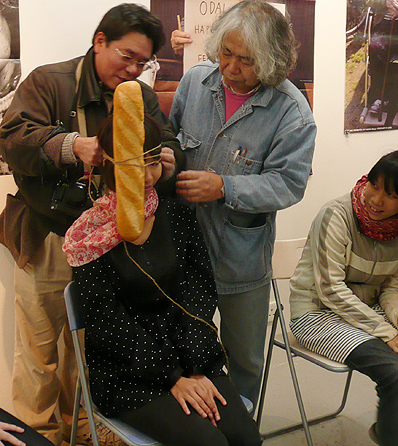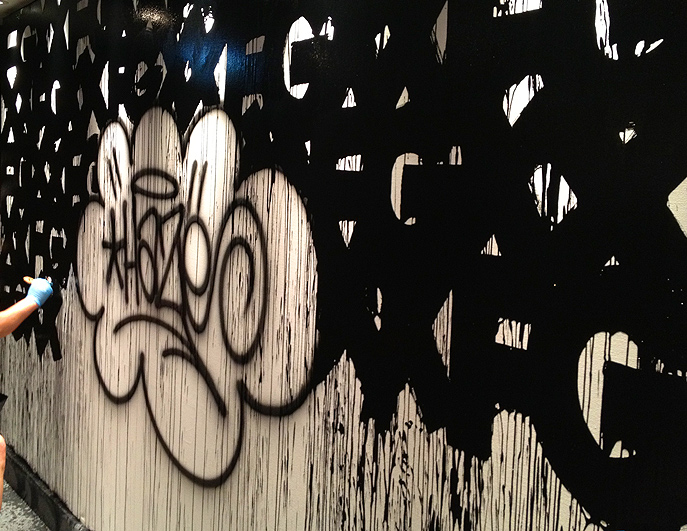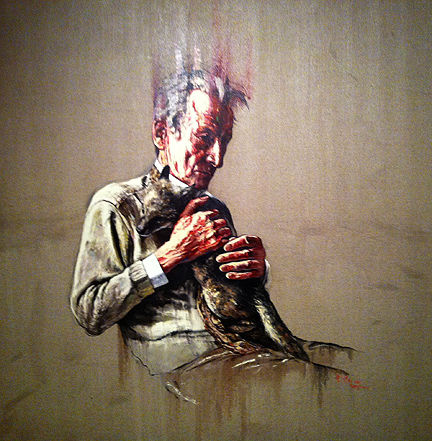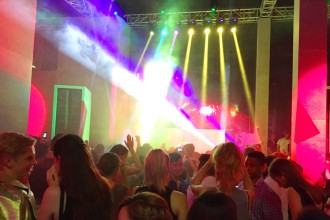
A few weeks ago I stumbled into the PARA / Site gallery in Sheung Wan just as Japanese artist Tatsumi Orimoto, also known as “the bread man,” was introducing his work.
The artist gave a short talk that sounded almost apologetic. He seemed to say: hey, people recognize me for this, and give my work attention because of this, so I have to keep on doing it. What he does is tie baguettes to people’s heads and then parades them around in public.
But does this type of performance gratify the insular art community at the expense of the general public?
[photopress:Bread_man_Orimoto_art.jpg,full,pp_image]Though I understand the nature of Orimoto’s work, and agree that it has artistic merit, unleashing it on the unwitting may actually alienate the average person from art and reinforce the stereotype of art as frivolous, impractical and crazy.
[photopress:Tatsumi_Orimoto_bread_art.jpg,full,pp_image] What’s the matter? Having second thoughts??? [photopress:bread_man_art_Hong_Kong.jpg,full,pp_image]The reason this bothers me is because the city’s art institutions only seem to be reaching a small segment of the population. Instead of breaking down walls to encourage art in the city, they sometimes seem to be putting them up.
One of my main criticisms of art institutions here is that they often fail at marketing the wonder and beauty of art to the average citizen.
In contrast, individuals and private companies in Hong Kong appear to understand how to market art much more effectively. The recent Carrie Chau exhibition at Times Square for example, was a massive success. The reaction of the crowds proved that the general public has both an interest in art and a sense of art appreciation.
Companies such as Agnes B., Louis Vuitton, Diesel, and Nike have championed local artists and brought interesting shows to Hong Kong. Likewise, individuals such as Edison from CLOT, and T.K. from Milk Magazine, have brought exciting new talent to the city and made art cool.
Why haven’t the city’s art institutions been leading? Perhaps government funding adds a level of bureaucracy that saps their zeal and inhibits their passion.
Or could it be that the institutions haven’t yet caught on to what art is to modern people? Maybe it’s not a question of lowering standards and dumbing things down, but understanding how art has evolved and comes in new forms.
[photopress:Tatsumi_Orimoto_bread_man.jpg,full,pp_image]



Very true, and quite sad. Even the major events held at the city’s top institutions are often conceived and promoted by outsiders – the superb exhibitions of Le French May come to mind.
Thanks for helping to raise awareness.
I agree with your premise, however I would argue that Carrie Chau’s work at Time’s Square, as well as other high-profile shows/exhibitions in HK, only attract the masses because the masses happen to be in the vicinity shopping or because there is a party on opening night where someone might be “seen”.
We probably agree that HK does not have a mature art “scene” per se, as dynamic as it may be at times, but is this the fault of local institutions/orgs or is it a by-product (symptom?) of local culture?
This is not a blind criticism of Chinese culture; it is a semi-educated guess that contemporary genres, besides film and digital content, are not fully appreciated yet, and will take another generation to take root.
Will a new Arts Centre (West Kow-loooooooooooon?) help to develop this appreciation and ability to think abstractly about issues dealt with in contemporary art, even as mainland China’s handlers announce new means and methods for censorship?
That remains to be seen.
The same can be said about art in Hong Kong: it remains to be seen!
seen/scene
It’s funny, when I started off writing this post, my point initially was that H.K. didn’t have a mature art scene, or an educated public that could “get” the type of art that Tatsumi Orimoto does. After thinking about it more I changed my mind.
I actually think that the average person does have a sense of art appreciation, but it’s often not stimulated by the exhibitions presented by the institutions. I DO think contemporary genres are appreciated locally. I think it’s just the opposite, that older forms are not relevant and are often presented in a dry or dull way.
In regards to your point about location and the opening night effect, when I went to the recent Vivienne Westwood exhibition it had already been open for nearly a month. It was also located in out of the way Quarry Bay, a place I rarely visit. When I got there, it was crowded with people! So, I think with an attractive show you can draw a crowd. Just look at the success of the Chai Wan art spaces as well.
Staging a successful exhibition just takes vision and knowing how to package your show properly.
I think the real reason the art scene is improving is because of the Internet. Now people have much greater access to information from around the world and don’t need to rely on the slow moving institutions for exposure.
I think a new arts center in West Kowloon will help tremendously. If they hired Frank Gehry to build a monument similar to his Guggenheim design in Bilbao, people can’t help but be moved to have a greater interest, and be inspired.
If you put someone with passion for the arts, such as David Tang in charge, I think you would have a world class addition to the city, and a new destination for international art lovers – something that Hong Kong currently lacks. We could then really get away with calling ourselves “the Manhattan of Asia”!
I think your idea of what “good” art is suffers from some confusion. Yes, your point about Tatsumi Orimoto is well taken, that this level of conceptualism may be a few steps ahead of what the general population is ready for – but have you ever actually been to a city with a developed art scene? New York? Los Angeles? London? Paris? Berlin?
The sorts of projects that draw your praise, in general, would be dismissed outright as trifle in any of these cities. What the independent gallery scene is trying to do is offer an alternative to “street art” and hipster design. Graffiti was cool in 1988. It might have carried some weight in 1995. Graffiti hasn’t been cool (or relevant) for at least 12 years. Don’t get me started about skateboarding.
The problem is that Hong Kong has yet to distinguish between true judgments of quality and the sheen and finish of a commercially produced product or exhibition. It’s easy to make garbage look nice when you have lots of money. It’s harder to elevate truly innovative and thoughtful art to the same status when there isn’t that kind of support available.
Wendy,
I don’t agree with your first two paragraphs, but I like part of what you said in the third.
My point about Orimoto is just the opposite. What I’m saying is that Orimoto’s breadman work isn’t “a few steps ahead of the general population,” but rather an old fashioned view on what art is.
It’s a stereotype of art is that is gleefully embraced by the people that seek to define themselves as more enlightened than the general population.
I think that these elitists feel intimidated by the success of the exhibitions they deride as “commercial” and “hipster.” They also feel threatened by the success of street art and graffiti which bypasses their approval. They want to be the ones to define art in the city, but instead are content to just operate in their small circles, and maintain a smug attitude about the art sense of the general population. That to me is old fashioned. Hong Kong is now bursting with art of all kinds, which is what we try to cover on Hong Kong Hustle.